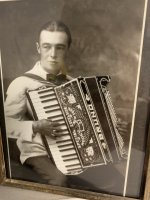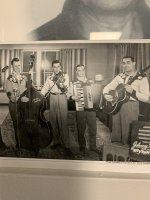Should you wish to remove the name from the front the letters will (probably a bit reluctantly) pop off in whole or in pieces if you angle the edge of a piece of hardwood against the base of each letter (angle as in the piece of wood as close as possible to in the same plane as the top of the accordion with the edge of the wood piece pushing sideways against the letter base) and then tap the wood briskly with a mallet or hammer.
The letters will pop off leaving an outline where they were glued on. Someone somewhrer might be able to buff out or otherwise remove the outline- but surely not I and I have tied, tried again, and tried thrice- to no avail.
A piece of black self adhesive celluloid sheeting readily availble as a guitar pick plate replacement is easily trimmed to cover the affected area and becomes pretty much undetectable. The accordion pictured had similar letters removed and now has a cover sheet installed over the top so you can see how it comes out.
You might glance at the back of the RH portion of the instrument. Many of the NY Specials and their clones had what was probably a cutting edge manufacturing materials featurel a cover plate on the back made of vinyl/plastic rather than fiberboard. With time these seem to have become really brittle and suffer from cracking. You can address the issue neatly either with a replacement made by yourself - easier said than done...- or by removing the backpiece and then contact cementing a sheet of leatherette fabrig over it. Trims up nicely, repairs the cracks quite well, and ought to last for another half century or so.
You could always just leave the name as a link to times gone by.
Good luck.





